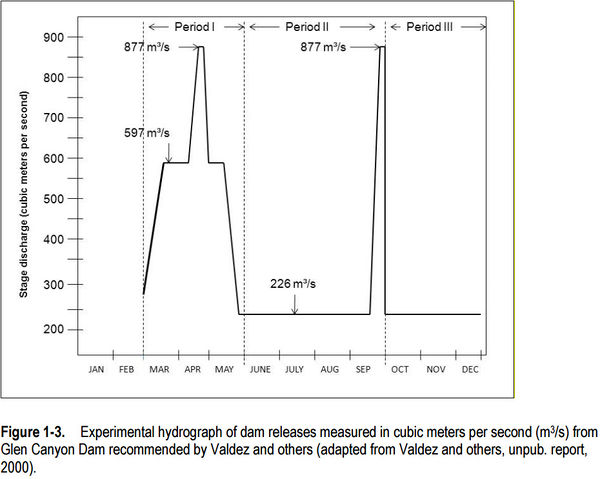Difference between revisions of "Low Summer Flow Experiment"
Cellsworth (Talk | contribs) |
Cellsworth (Talk | contribs) |
||
| Line 16: | Line 16: | ||
</table> | </table> | ||
| − | [[File: | + | [[File:2000LSSFhydrograph.jpg|600px]] |
<!-- | <!-- | ||
| Line 51: | Line 51: | ||
|style="color:#000;"| | |style="color:#000;"| | ||
| − | Low summer flows (minimum daily mean 5,000 to 8,000 cfs) for three months (Jul.–Sep.) to target | + | Low summer flows (minimum daily mean 5,000 to 8,000 cfs) for three months (Jul.–Sep.) to target ≥14°C at Little Colorado River confluence. <br> |
The experiment would '''not''' be conducted if: | The experiment would '''not''' be conducted if: | ||
| − | # | + | # Release temperatures were too low to reach 14°C at Little Colorado River confluence even with going to a minimum flow of 5,000 to 8,000 cfs, or |
| − | # | + | # Release temperature were predicted to be high enough in July, August, or September to reach 14°C at Little Colorado River confluence under normal operations. |
|- | |- | ||
| Line 72: | Line 72: | ||
'''Subsequent experimental use if:''' | '''Subsequent experimental use if:''' | ||
| − | # | + | # Initial test was successful, |
| − | # | + | # Humpback chub population concerns warrant their use, |
| − | # | + | # Water temperature appears to be limiting recruitment, and |
| − | # | + | # Target temperature of ≥14°C could be achieved only with low summer flow. |
|- | |- | ||
| Line 84: | Line 84: | ||
*Low summer flows do not increase growth and recruitment of humpback chub | *Low summer flows do not increase growth and recruitment of humpback chub | ||
*Increase in warmwater nonnative species or trout at the Little Colorado River | *Increase in warmwater nonnative species or trout at the Little Colorado River | ||
| − | *Longterm unacceptable adverse impacts on the resources listed in Section 1.3 are observed | + | *Longterm unacceptable adverse impacts on the resources listed in Section 1.3 are observed, or |
| − | * | + | *Sufficient warming does not occur as predicted |
|- | |- | ||
| Line 92: | Line 92: | ||
|style="color:#000;"| | |style="color:#000;"| | ||
| − | * | + | *Reduced food availability to humpback chub by |
# desiccating the nearshore environment with the reduction in flow between June and July, and | # desiccating the nearshore environment with the reduction in flow between June and July, and | ||
# reducing drift with the reduction in daily fluctuation. | # reducing drift with the reduction in daily fluctuation. | ||
| − | * | + | *Increased bioenergetic demands of humpback chub via warmer water while decreasing food supply and availability. |
| − | * | + | *Increased sediment transport during the high releases in the months prior to the LFS test in order to get the annual volume commitment to the Lower Basin. |
| − | * | + | *Increased the potential for nonnative fish and parasites to proliferate throughout the Grand Canyon. |
|- | |- | ||
Revision as of 16:53, 2 May 2017
|
|
LTEMP Experimental Action: Aquatic Resource-Related Experimental Treatments (BA, pages 30-41) [1]Low summer flows may be tested in the second 10 years of the LTEMP period, for the purpose of achieving warmer river temperatures (≥14°C) to benefit humpback chub and other native species. Under low summer flows, daily fluctuations would be less than under base operations (e.g., approximately 2,000 cfs). Investigating the anticipated effects of and options for providing warmer water temperatures in the mainstem Colorado River through Grand Canyon is an identified management action in the Humpback Chub Recovery Goals (USFWS 2002a). |
| --- |
--- |
--- |
|---|
|
|
